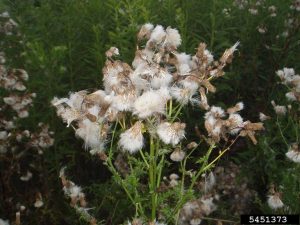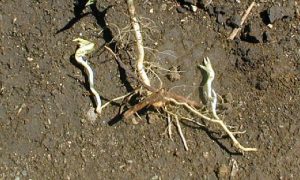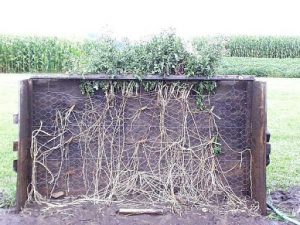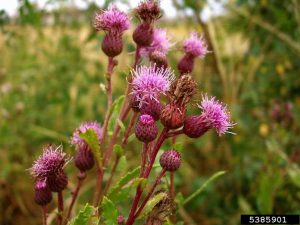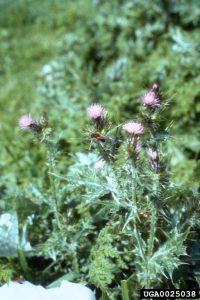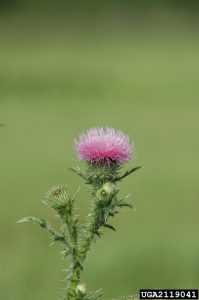One of the most common weeds that present significant challenges to both landscapers and growers are thistles. There are several reasons that thistles are difficult to control, including thousands of viable seeds per plant (Fig. 1), rhizomatous growth characteristics (Canada thistle) (Fig. 2), and large root system (Fig. 3).
- Figure 1. Canada thistle can produce up to 1,500 seeds per flowering stalk, contributing to significant wind-blown dispersal. Image: Leslie J. Mehrhoff, University of Connecticut, Bugwood.org
- Figure 2. New Canada thistle shoots developing from buds on roots. Photo: Fabian Menalled, Ecology and Management of Canada Thistle, 2005. https://www.researchgate.net/publication/242497779_Ecology_and_Management_of_Canada_thistle_Cirsium_arvense_L_Scop
- Figure 3. Two years of underground growth of Canada thistle from original one foot of root. Photo: Merrill Ross, Control Practices for Canada thistle. https://www.btny.purdue.edu/Pubs/WS/CanadaThistle/CanadaThistle.html
There are three major types of thistle that are encountered in the Midwest:
- Canada Thistle (Cirsium arvense)
- Musk Thistle (Carduus nutans)
- Bull Thistle (Cirsium vulgare)
There are also several sowthistle species, which we won’t cover in this article.
To begin understanding these thistle species, it’s important to understand the life cycles of each.
Canada thistle: a rhizomatous perennial that reproduces at the rhizome nodes (Fig. 2) and via seed dispersal in the wind (Fig. 1).
Bull thistle: a biennial that spends its first year as a basal rosette, followed by the second year reproductive phase. Reproduces via wind-blown seed dispersal.
Musk thistle: a biennial (sometimes a winter annual) that begins as a basal rosette followed by reproduction in the second year. Reproduces via wind-blown seed dispersal.
Canada thistle characteristics:
- Leaves are lobed with spiny margins. The upper leaf surface is dark green and hairless, while the lower surface is light green with or without sparse hairs. Leaves are alternate, sessile, and oblong.
- Cotyledons are dull green, thick, rounded oval. Younger leaves are thick, egg-shaped, and covered with short, bristly hairs with margins that are wavy-lobed with sharp spines. Since many new plants come from the rhizomes, some plants will not have a cotyledon.
- Stems are erect, smooth or slightly hairy, and branch at the apex.
- In addition to wind-blown seed, Canada thistle has a very extensive rhizome system. Roots and rhizomes can reach more than three feet.
- Pink to purple flowers can be found June through August (Fig. 4).
- Figure 4. Canada thistle flowers. Photo: Jan Samanek, Phytosanitary Administration, www.bugwood.org.
- Figure 5. Musk thistle flowers. Photo: USDA ARS , USDA Agricultural Research Service, Bugwood.org
Musk thistle characteristics:
- Both leaves and stems are spiny.
- Cotyledons are oblong and sessile with white veins. Leaves are waxy and pale green with shallowly lobed leaf margins that are prickly-toothed.
- After the basal rosette stage, stems are erect and leaves are deeply pinnately lobed and alternate. The leaf margins are spiny-tipped. Long hairs can be found on the main veins. Leaf bases extend down the stem.
-
A long, thick tap root that can reach 16” deep.
- Pink to purple flowers begin in June and can last until October (Fig. 5).
Bull thistle characteristics:
- Alternate leaves are covered in a coarse, cobweb-like hairs with stiff spines on the lobes. Leaves are lanceolate with deep-toothed margins, coarse hairs on the upper surface and soft, whitish hairs below.
- Stems are erect and branched.
- Cotyledons are egg-shaped. Young leaves are oval with spines on the fringe. As plant grows, leaves become longer, more lanceolate, and have spine tipped lobes.
- The first year a taproot forms, followed by a secondary, fibrous root system.
- Red to purple flowers can be found June to October with spine-tipped bracts (Fig. 6).
Cultural Control:
Cultivation is effective at controlling musk and bull thistle, but can actually increase the infestation of Canada thistle. Mulching can help in reducing the germination percentage of wind-blown seeds. Preventing Canada thistle roots and rhizomes when bringing soil into a property is effective in preventing an infestation.
Biological Control:
Though there are some insects that use thistles for a food source, there are no effective biological control options.
Chemical Control:
Musk and bull thistle are much easier to control than Canada thistle, though their chemical control options are the same. To prevent wind-blown seeds from germinating, a preemergence application in the spring and fall is recommended. The two most effective products for control of thistle via preemergence are Casoron (dichlobenil) and Sureguard/Broadstar (flumioxazin). To effectively control Canada thistle, a postemergence program is very important. The most effective product for post control on Canada thistle (as well as the other thistles) is Lontrel (clopyralid). Other options to also consider include, Manor/Ally (metsulfuron), Basagran (bentazon), and glyphosate (when plants are less than 6” tall). To rid a property of an infestation of Canada thistle will require multiple applications of a postemergence herbicide as well as a fall and spring preemergence application to deplete the weed seed bank of thistle seeds. The smaller the plant, a postemergence application will be much more effective due to the root system of all three species of these thistles.
Reference:
Uva, R.H., Neal, J.C., and DiTomaso, J.M. 1997. Weed of the Northeast. Cornell University Press. 397 pgs. https://www.cornellpress.cornell.edu/book/9780801483349/weeds-of-the-northeast/#bookTabs=1
